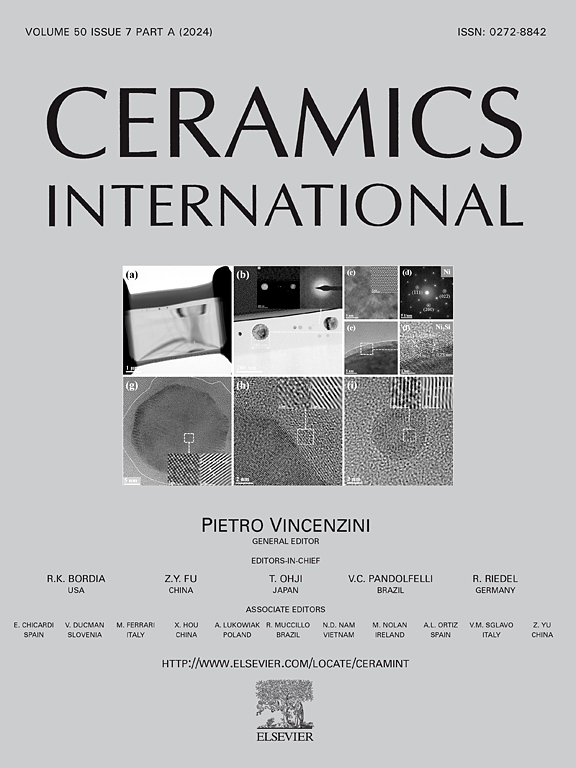Competitive reaction behavior and formation mechanism of reactively spark plasma sintered TiB2-TiC composite ceramics with tunable compositions
IF 5.1
2区 材料科学
Q1 MATERIALS SCIENCE, CERAMICS
引用次数: 0
Abstract
TiB2-TiC composite ceramics with tunable compositions (70 wt% < TiB2 < 100 wt%) were fabricated by the reactive spark plasma sintering (SPS) technique using Ti, B4C, and TiB2 as raw materials. The effects of sintering temperature and holding time on the densification, electrical, and mechanical properties of composite ceramics were investigated. Additionally, the competitive reaction behavior of the Ti-B4C-TiB2 ternary system and the formation mechanism of TiB2-TiC composite ceramics were systematically highlighted, respectively. The TiB2-TiC composite ceramics successfully obtained 98.9 % relative density, 8.0 ± 0.3 μΩ∙cm electrical resistivity, and 6.8 ± 0.2 MPa∙m1/2 fracture toughness at the sintering temperature of 1800 °C, pressure of 35 MPa, and holding time of 5 min. As the sintering temperature was increased in the Ti-B4C-TiB2 ternary system, competitive reactions occurred not only between Ti and B4C as well as between Ti and TiB2 reactants, but also between B4C and in-situ generated TiC, accompanied by the formation of TiB and free carbon in the system. The enhancement of fracture toughness could be attributed to the generation of TiB. Meanwhile, the establishment of a conductive network, which was promoted by the presence of free carbon, resulting in significant reduction in electrical resistivity. However, as a consequence of the deformation and dissociation of the free carbon, a reduction in the load-bearing cross-section resulted in a corresponding reduction in the flexural strength of the composite ceramic.
求助全文
约1分钟内获得全文
求助全文
来源期刊

Ceramics International
工程技术-材料科学:硅酸盐
CiteScore
9.40
自引率
15.40%
发文量
4558
审稿时长
25 days
期刊介绍:
Ceramics International covers the science of advanced ceramic materials. The journal encourages contributions that demonstrate how an understanding of the basic chemical and physical phenomena may direct materials design and stimulate ideas for new or improved processing techniques, in order to obtain materials with desired structural features and properties.
Ceramics International covers oxide and non-oxide ceramics, functional glasses, glass ceramics, amorphous inorganic non-metallic materials (and their combinations with metal and organic materials), in the form of particulates, dense or porous bodies, thin/thick films and laminated, graded and composite structures. Process related topics such as ceramic-ceramic joints or joining ceramics with dissimilar materials, as well as surface finishing and conditioning are also covered. Besides traditional processing techniques, manufacturing routes of interest include innovative procedures benefiting from externally applied stresses, electromagnetic fields and energetic beams, as well as top-down and self-assembly nanotechnology approaches. In addition, the journal welcomes submissions on bio-inspired and bio-enabled materials designs, experimentally validated multi scale modelling and simulation for materials design, and the use of the most advanced chemical and physical characterization techniques of structure, properties and behaviour.
Technologically relevant low-dimensional systems are a particular focus of Ceramics International. These include 0, 1 and 2-D nanomaterials (also covering CNTs, graphene and related materials, and diamond-like carbons), their nanocomposites, as well as nano-hybrids and hierarchical multifunctional nanostructures that might integrate molecular, biological and electronic components.
 求助内容:
求助内容: 应助结果提醒方式:
应助结果提醒方式:


